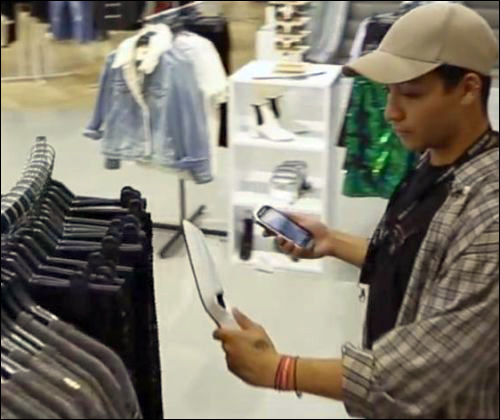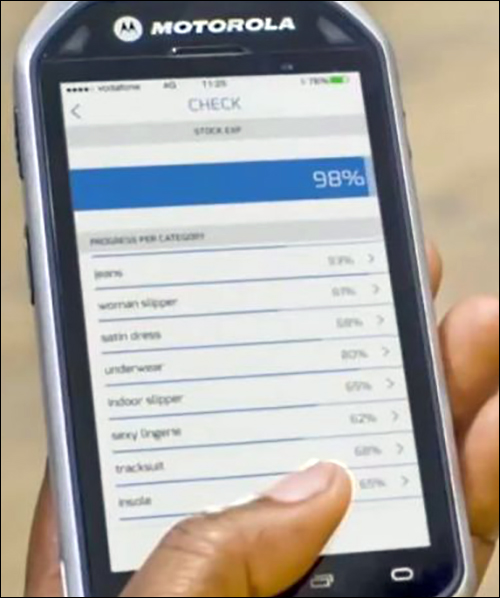Fashion retailer River Island is rolling out a radio frequency identification solution at all 280 of the stores it owns and operates. The retailer will track all of the garments it sells within the 280 stores, which are located in United Kingdom, Ireland, the Netherlands and Belgium, using tags applied by suppliers.
However wide-scale the deployment may be, though, the RFID system’s use case is concentrated on only a single process, says Jon Wright, River Island’s head of global loss prevention and safety. The deployment—consisting of the !D Cloud EPC ultrahigh-frequency (UHF) RFID solution from Nedap Retail, based in the Netherlands—will initially monitor only the overall inventory levels within each store, and thereby enable a more accurate automated replenishment, with the goal of boosting sales.
The deployment follows a multi-phase pilot carried out at a total of seven stores during the course of several years. According to the company, the pilot showed that the RFID technology raised River Island’s inventory accuracy to 97 percent, while also significantly boosting sales.

River Island has taken a systematic approach to its RFID deployment, Wright explains, beginning with identifying the best use case and testing it at several stores, then measuring the results and planning how to roll out the technology in stages.
Wright joined the company three years ago to lead its global loss-prevention efforts, bringing a background in RFID. From the outset, he says, he planned to investigate how the technology could benefit the retailer by improving its inventory accuracy, in order to increase sales and enable omnichannel purchases via the internet. The company considered multiple RFID vendors before choosing Nedap, but found that the solutions they offered were too rigid for River Island’s requirements. While most retailers seek to deploy the system for multiple functions, he adds—such as loss prevention, expediting transactions at the point of sale or tracking goods moving from the stock room to the sales floor—River Island wanted to start with a simpler approach.
“We decided the best approach was to be laser-focused on what would provide the biggest bang for our buck,” Wright says—and the function that provided the most impact, he notes, would be full store stock levels (as opposed to tracking where goods were located within the store). By having sufficient product at each location, River Island expects to reduce the risk of sales losses by triggering automatic replenishment orders when inventory for any given stock-keeping unit (SKU) drops to a certain level.
River Island’s pilot RFID deployments diverged from the approach taken by many retailers in terms of selecting which SKUs to tag. While some RFID technology vendors recommend beginning with an RFID pilot that involves the tagging of certain fast-moving products, Wright says, such an approach would not have been effective at River Island’s stores. That, he explains, is because fast-moving items like denim jeans tend to be stocked in higher volumes at stores, in order to prevent out-of-stocks so those goods are rarely missing from store shelves.
Instead, for its first phase—a three-month, three-store pilot deployment that took place approximately two years ago—River Island attached RFID tags to every clothing item (non-jewelry accessories were not tagged) at each store. The retailer’s distribution center in Milton Keynes, England, segregated those goods going to the three locations, then tagged them with bar-coded labels made with Alien Technology Higgs 4 RFID chips and provided by Byways Group. River Island used Nedap’s !D Cloud software hosted on a cloud-based server, which collected inventory data from the retailer’s own management software. Store employees utilized a Nedap !D Hand 2 reader in conjunction with Nedap’s !D Cloud app running on Android-based mobile devices to perform inventory counts of the tagged merchandise.
The tags were read during weekly inventory checks, as well as on occasions when a customer returned a tagged product. For inventory counts, the !D Cloud app displayed the number of items for each SKU whose tags had been interrogated, along with what was missing, based on what should be onsite according to the retailer’s own software. The !D Hand 2 reader captured the tag ID numbers and forwarded that data to the Android device via a Bluetooth connection. The app updated the inventory information and transmitted that data to the cloud-based server.
The !D Cloud software then shared the inventory count data with River Island’s stock-management software, so that replenishment orders could be placed automatically.
In the case of returned products, if the RFID tag were still attached to a garment or piece of jewelry, store personnel would simply read that item’s tag ID and update the status as returned. If there were no label attached, they would then program a new RFID label with the !D Hand 2 and attach it to that product, which would then be returned to the sales floor.
River Island had three key performance indicators (KPIs) for the pilot. It sought to achieve a 95 percent stock level accuracy at each store, increase sales and receive positive feedback from workers regarding products’ in-store availability. After three months, Wright reports, River Island had accomplished all three goals. The company then removed the technology and observed that the KPIs decreased to previous levels once the system was no longer in place. It later held another three-month pilot at three different stores, handing responsibility for the system’s use and data management over to a team of employees at each location. During phase three, the company tested the system at a flagship store and developed a methodology to test whether the sales increase was, indeed, the result of RFID technology—such as tracking sales rates for each SKU and checking to see if sales gaps (caused by goods being out of stock) were eliminated.
The company has now entered phase four, consisting of a full rollout to all 280 stores, with about three sites already having taken the system live. The goal is to deploy the RFID technology at all stores by the end of 2017, the company reports, using RFID labels made with Impinj Monza R6-P RFID chips. The retailer plans to install the solution at most of its stores between May and October. The distribution center is still tagging goods already located at its facility. However, River Island’s suppliers are now also applying RFID tags to goods they ship to the DC, and those products are expected to be in the supply chain or in stores by May, at which point the DC will no longer need to tag merchandise itself.
The enterprise-wide rollout will be the largest such project that Nedap has undertaken with full responsibility for the project, according to Danny Haak, Nedap Retail’s !D Cloud product manager. He expects this kind of large-scale rollout to become more commonplace, he adds, once it has proven to be successful by retailers like River Island. “Making a solution that counts items in the store is one thing,” Haak states, “but making sure it is able to do this in hundreds of stores without being disruptive to in-store processes and existing IT infrastructure is another matter.”
The !D Cloud system not only enables store personnel onsite to view inventory data on the handheld reader, but also lets a retailer’s managers view the information from a central location.
The app allows for multiple workers to simultaneously count inventory on a single site, Haak says, “which is especially useful for the large stores.” In the event that several of a store’s employees are conducting inventory counts at the same time, he notes, the app will update the count in real time for all personnel using the readers.
Eventually, Wright says, he hopes workers at River Island’s DC will use the technology to track when goods arrive at the facility and are then shipped out, as well as to conduct inventory counts onsite. The solution will enable River Island to also begin fulfilling omnichannel sales of its products to customers who place orders online, by identifying which products are geographically closest to a particular online shopper, and by shipping from that location.
Wright expects the technology eventually to be used for monitoring when goods leave a store’s back room, and when they are put out on the sales floor.
But first, he says, his team wants to see a return on investment for the initial RFID deployment, based on increased sales due to inventory accuracy. He declines to reveal the amount by which sales increased during the pilots with the technology in place, but reports that the lift exceeded the company’s expectations.
Since River Island first began piloting the technology, Wright says, the system has proven to provide the benefits the retailer was looking to achieve. “It’s not very often you find a loss-prevention team owning a technology that has nothing to do with loss prevention,” he notes. Nonetheless, he reports, he and his team have been pleased with the results.



